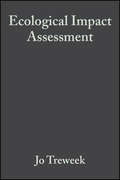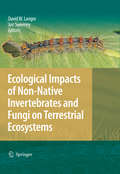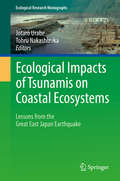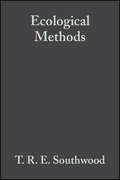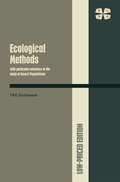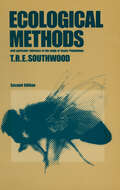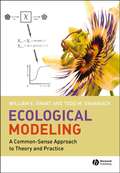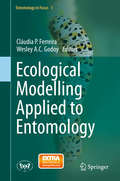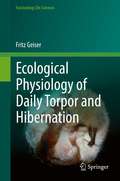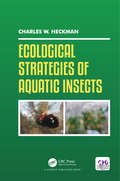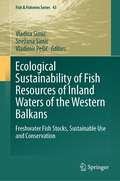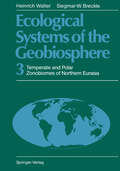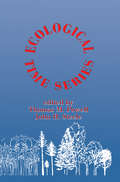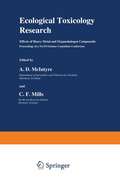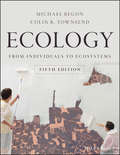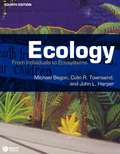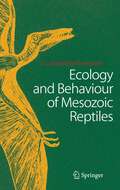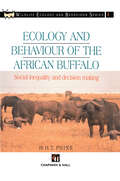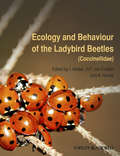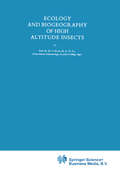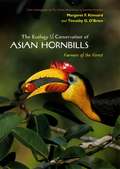- Table View
- List View
Ecological Impact Assessment
by Jo TreweekThe world's ecosystems are increasingly threatened by human development. Ecological impact assessment (EcIA) is used to predict and evaluate the impacts of development on ecosystems and their components,thereby providing the information needed to ensure that ecological issues are given full and proper consideration in development planning. Environmental impact assessment (EIA) has emerged as a key to sustainable development by integrating social, economic and environmental issues in many countries. EcIA has a major part to play as a component of EIA but also has other potential applications in environmental planning and management. Ecological Impact Assessment provides a comprehensive review of the EcIA process and summarizes the ecological theories and tools that can be used to understand, explain and evaluate the ecological consequences of development proposals. It is intended for the many individuals and companies involved in EIA and EcIA, as well as other areas of environmental management where impacts on ecosystems need to be evaluated. It will benefit planners, regulators, environmental consultants and scientists and will also provide an invaluable sourcebook and guide for the growing number of undergraduate students taking courses in applied ecology, EIA and related topics in environmental science. A practical management guide for the increasing numbers of practitioners of EcIA. A rapidly expanding subject driven by the proliferation of environmental legislation worldwide.
Ecological Impacts of Non-Native Invertebrates and Fungi on Terrestrial Ecosystems
by David Langor Jon SweeneySince the arrival of Europeans about 500 years ago, an estimated 50,000 non-native species have been introduced to North America (including Hawaii). Non-native species figure prominently in our lives, often as ornamentals, sources of food or pests. Although many introduced species are beneficial, there is increasing awareness of the enormous economic costs associated with non-native pests. In contrast, the ecological impacts of non-native species have received much less public and scientific attention, despite the fact that invasion by exotic species ranks second to habitat destruction as a cause of species loss. In particular, there is little information about the ecological impacts of hyper-diverse groups such as terrestrial fungi and invertebrates. A science symposium, Ecological impacts of non-native invertebrates and fungi on terrestrial ecosystems, held in 2006, brought together scientists from the USA and Canada to review the state of knowledge in this field of work. Additional reviews were solicited following the symposium. The resulting set of review/synthesis papers and case studies represents a cross-section of work on ecological impacts of non-native terrestrial invertebrates and fungi. Although there is a strong focus on Canadian work, there is also significant presentation of work in the northern USA and Europe.
Ecological Impacts of Tsunamis on Coastal Ecosystems: Lessons from the Great East Japan Earthquake (Ecological Research Monographs)
by Jotaro Urabe Tohru NakashizukaThis book focuses on the ecological impacts of the Great East Japan Earthquake and resulting tsunamis, a rare and extremely large disturbance event, on various coastal ecosystems in Japan’s Tohoku area, including sub-tidal and tidal animal communities, sand dune plant communities and coastal forests. The studies presented here describe not only how species and populations in these ecosystems were disturbed by the earthquake and tsunamis, but also how the communities have responded to the event and what types of anthropogenic activities will hamper their recovery processes. In the ecological sciences, it is often argued that large disturbances are critical to shaping community structures and biodiversity in local and regional habitats. However, our understanding of these roles remains limited, simply because there have been few opportunities to examine and address the ecological impacts of large disturbance events. The scale of the 2011 Great East Japan Earthquake makes it one of the largest hazards in the past 1000 years. Thus, this book provides a unique opportunity to advance our understanding of the ecological impacts of large and rare disturbances and the implications of these events in the conservation and management of coastal ecosystems. Following an outline of the Great East Japan Earthquake, the book’s content is divided into two major parts. Part I reports on studies examining the ecological impacts of the tsunamis on sub-tidal and tidal animal communities, while Part II focuses on terrestrial plant communities in Japan’s coastal Tohoku area. This book will benefit all scientists interested in the ecological impacts of large disturbances on aquatic and terrestrial ecosystems in general, and especially those who are interested in the ecological management of coastal ecosystems and Ecosystem based Disaster Risk Reduction (EcoDRR).
Ecological Methods
by T. R. Southwood Peter A. HendersonThis classic text, whose First Edition one reviewer referred to as "the ecologists' bible," has been substantially revised and rewritten. Not only have the advances made in the field since the Second Edition been taken into account, but the scope has been explicitly extended to all macroscopic animals, with particular attention being paid to fish as well as other vertebrates. Ecological Methods provides a unique synthesis of the methods and techniques available for the study of populations and ecosystems. Techniques used to obtain both absolute and relative population estimates are described, and approaches to the direct measurement of births, deaths, migration and the construction and interpretation of life tables are reviewed. The text is extensively illustrated, clearly describing a wide range of equipment and methods of analysis. Comprehensive and up-to-date bibliographies to each chapter fully cover the relevant literature, and references are given to available computer programs and internet addresses. The book has an active web site providing additional illustrations, details of equipment and programs, and references to work published since the revision was completed. Like the earlier editions, this book will be an indispensable source of reference to researchers and students at all levels in the fields of ecology, entomology and zoology. Completely revised and rewritten edition of a classic. Scope extended to all macroscopic animals, notably fish and other vertebrates. Active web site displaying additional material. References to computer programmes and internet addresses throughout the text. Affordable paperback.
Ecological Methods: With Particular Reference to the Study of Insect Populations
by T.R. Southwoodthe virtual impossibility of extracting the many different species from a habitat with equal efficiency by a single method (e.g. Nef, 1960). 1.1 Population estimates Population estimates can be classified into a number of different types; the most convenient classification is that adopted by Morris (1955), although he used the terms somewhat differently in a later paper (1960). 1.1.1 Absolute and related estimates The animal numbers may be expressed as a density per unit area of the ground of the habitat. Such estimates are given by nearest neighbour and related techniques (Chapter 2), marking and recapture (Chapter 3), by sampling a known fraction of the habitat (Chapter 4-6) and by removal sampling and random walk techniques (Chapter 7). Absolute population The number of animals per unit area (e.g. hectare, acre). It is almost impossible to construct a budget or to study mortality factors without the conversion of population estimates to absolute figures, for not only do insects often move from the plant to the soil at different developmental stages, but the amount of plant material is itself always changing. The importance of obtaining absolute estimates cannot be overemphasized.
Ecological Modeling: A Common-Sense Approach to Theory and Practice
by William E. Grant Todd M. SwannackEcological Modeling:A Commonsense Approach to Theory and Practice explores how simulation modeling and its new ecological applications can offer solutions to complex natural resource management problems. This is a practical guide for students, teachers, and professional ecologists. Examines four phases of the modeling process: conceptual model formulation, quantitative model specification, model evaluation, and model use Provides useful building blocks for constructing systems simulation models Includes a format for reporting the development and use of simulation models Offers an integrated systems perspective for students, faculty, and professionals Features helpful insights from the author, gained over 30 years of university teaching "I can strongly recommend the book as textbook for all courses in population dynamic modeling particularly when the course is planned for the second or third year of a bachelor study in ecology, environmental science or ecological engineering. It uncovers very clearly for the readers the scientific idea and thinking behind modeling and all the necessary steps in the development of models." Ecological Modeling Journal, 2009
Ecological Modeling: A Common-Sense Approach to Theory and Practice
by William E. Grant Todd M. SwannackEcological Modeling:A Commonsense Approach to Theory and Practice explores how simulation modeling and its new ecological applications can offer solutions to complex natural resource management problems. This is a practical guide for students, teachers, and professional ecologists. Examines four phases of the modeling process: conceptual model formulation, quantitative model specification, model evaluation, and model use Provides useful building blocks for constructing systems simulation models Includes a format for reporting the development and use of simulation models Offers an integrated systems perspective for students, faculty, and professionals Features helpful insights from the author, gained over 30 years of university teaching "I can strongly recommend the book as textbook for all courses in population dynamic modeling particularly when the course is planned for the second or third year of a bachelor study in ecology, environmental science or ecological engineering. It uncovers very clearly for the readers the scientific idea and thinking behind modeling and all the necessary steps in the development of models." Ecological Modeling Journal, 2009
Ecological Modelling Applied to Entomology (Entomology in Focus #1)
by Cláudia P. Ferreira Wesley A.C GodoyInsects, when studied from the ecological perspective, provide a great opportunity for scientific studies emphasizing population theory. The simple fact of being successful organisms for their ability to colonize different habitats or even for their high reproductive potential, increases the interest of ecologists in conducting studies focused on population and community level. Mathematical models are powerful tools that can capture the essence of many biological systems and investigate ecological patterns associated to ecological stability dependent on endogenous and exogenous factors. This proposal comes from the idea of adding experiences of researchers interested in working at the interface between mathematical and computation theory and problems centered on entomology, showing how mathematical modelling can be an important tool for understanding population dynamics, behavior, pest management, spatial structure and conservation.
Ecological Physiology of Daily Torpor and Hibernation (Fascinating Life Sciences)
by Fritz GeiserThis book provides an in-depth overview on the functional ecology of daily torpor and hibernation in endothermic mammals and birds. The reader is well introduced to the physiology and thermal energetics of endothermy and underlying different types of torpor. Furthermore, evolution of endothermy as well as reproduction and survival strategies of heterothermic animals in a changing environment are discussed.Endothermic mammals and birds can use internal heat production fueled by ingested food to maintain a high body temperature. As food in the wild is not always available, many birds and mammals periodically abandon energetically costly homeothermic thermoregulation and enter an energy-conserving state of torpor, which is the topic of this book. Daily torpor and hibernation (multiday torpor) in these heterothermic endotherms are the most effective means for energy conservation available to endotherms and are characterized by pronounced temporal and controlled reductions in body temperature, energy expenditure, water loss, and other physiological functions. Hibernators express multiday torpor predominately throughout winter, which substantially enhances winter survival. In contrast, daily heterotherms use daily torpor lasting for several hours usually during the rest phase, some throughout the year. Although torpor is still widely considered to be a specific adaptation of a few cold-climate species, it is used by many animals from all climate zones, including the tropics, and is highly diverse with about 25-50% of all mammals, but fewer birds, estimated to use it. While energy conservation during adverse conditions is an important function of torpor, it is also employed to permit or facilitate energy-demanding processes such as reproduction and growth, especially when food supply is limited. Even migrating birds enter torpor to conserve energy for the next stage of migration, whereas bats may use it to deal with heat. Even though many heterothermic species will be challenged by anthropogenic influences such as habitat destruction, introduced species, novel pathogens and specifically global warming, not all are likely to be affected in the same way. In fact it appears that opportunistic heterotherms because of their highly flexible energy requirements, ability to limit foraging and reduce the risk of predation, and often pronounced longevity, may be better equipped to deal with anthropogenic challenges than homeotherms. In contrast strongly seasonal hibernators, especially those restricted to mountain tops, and those that have to deal with new diseases that are difficult to combat at low body temperatures, are likely to be adversely affected. This book addresses researchers and advanced students in Zoology, Ecology and Veterinary Sciences.
Ecological Strategies of Aquatic Insects
by Charles W. HeckmanThis book recounts the habits of many interesting and unusual exceptions to the rule that insects are typically terrestrial forms of life. It examines the different ways that groups of species have developed modes of existence in or on the surface of water, and gives reasons why the gross morphology of insects is not favorable for life in or near bodies of water, such as wings that fail to function after coming into contact with water, rendering them useless.
Ecological Strategies of Aquatic Insects
by Charles W. HeckmanThis book recounts the habits of many interesting and unusual exceptions to the rule that insects are typically terrestrial forms of life. It examines the different ways that groups of species have developed modes of existence in or on the surface of water, and gives reasons why the gross morphology of insects is not favorable for life in or near bodies of water, such as wings that fail to function after coming into contact with water, rendering them useless.
Ecological Sustainability of Fish Resources of Inland Waters of the Western Balkans: Freshwater Fish Stocks, Sustainable Use and Conservation (Fish & Fisheries Series #43)
by Vladica Simić Snežana Simić Vladimir PešićThis book provides a detailed evaluation of the hydro-ecological characteristics of the Western Balkans, an area characterized by still preserved inland waters and fish resources important for the European continent, as well as the biodiversity of inland waters important for the planet Earth. Freshwater ecosystems cover only 1% of the Earth's surface; however, they are a habitat for about 40% of fish species. At the same time, inland fisheries make less than 12% of the world's global fish catch, with 43% coming from low-income and food-deficient countries (Africa, South America, Southeast Asia). In Europe, the Western Balkans have significant fishing waters and fish resources, including the Middle Danube drainage (Sava, Drina, Velika Morava river systems), large ancient lakes (Skadar/Shkodra, Ohrid, Prespa, Dojran), and the Adriatic basin characterized by endemic and commercially important species. However, in contrast to the high fishing potential in a significant part of the Western Balkans, diverse and specific political, economic, and social factors largely had a negative impact on the state of fish resources. This volume is multidisciplinary and provides a sound knowledge base for scientific and practical fisheries. In addition, it may be a valuable guide for managers and conservationists worldwide to adapt methods and procedures for the ecological sustainability of fish resources under specific local, natural, and socio-economic conditions. Finally, the content is a good reference for natural sciences and agriculture students studying fish, fish resources, and fisheries sciences. It would improve their knowledge and perspectives on the challenges of sustainable use and conservation of inland water resources.
Ecological Systems of the Geobiosphere: 3 Temperate and Polar Zonobiomes of Northern Eurasia
by Heinrich Walter Siegmar-W. BreckleBy the end of the last century, the only region in all of Europe where the natural vegetation remained untouched over large expanses was Eastern Europe. Information on the vegetation of this region however, remained mostly unavailable to western scientists although the ecological approach to botanical research originated in Eastern Europe. Heinrich Walter was born in Russia, studied Natural Sciences - with emphasis on botany - in Odessa and is familiar with all relevant Russian literature on ecology. This volume thus offers scientists worldwide a unique and comprehensive survey of all relevant research, including the mostly unknown literature published in Russian.
Ecological Time Series
by Thomas M. Powell John H. SteeleThis book results from a summer school held at Cornell University in 1992. The participants were graduate students and postdoctoral researchers selected from a broad range of interests and backgrounds in ecological studies. The summer school was the second in a continuing series whose underlying aim and the aim of this volume-is to bring together the different methods and concepts underpinning terrestrial, freshwater, and marine ecology. The first volume in the series focused on patch dynamics in these three ecologi cal sectors. Here we have endeavored to complement that volume by extending its comparative approach to the consideration of ecological time series. The types of data and the methods of collection are necessarily very different in these contrasting environments, yet the underlying concept and the technical problems of analysis have much in common. It proved to be of great interest and value to the summer school participants to see the differences and then work through to an appreciation ofthe generalizable concepts. We believe that such an approach must have value as well for a much larger audience, and we have structured this volume to provide a comparable reading experience.
Ecological Toxicology Research: Effects of Heavy Metal and Organohalogen Compounds
by A. D. McIntyre C. F. MillsThe Conference on the Ecotoxicity of Heavy Metals and Organohalogen Com pounds was held under the auspices of the NATO Science Committee as part of its continuing effort to promote the useful progress of science through international cooperation. Science Committee Conferences are deliberately designed to focus atten tion on unsolved problems, with invited participants providing a variety of complementary expertise. Through intensive group discussion they seek to reach a consensus on assessments and recommendations for future research emphases, which it is hoped will be of value to the larger scientific commu nity. The subjects treated in previous Conferences have been as varied as science itself-e.g., computer software, chemical catalysis, oceanography, and materials and energy research. This volume presents an account of a meeting which evolved from studies within the Science Committee's advisory panel on Eco-Sciences. Environmental monitoring of toxic substances from industrial and agricultural sources is pro ducing a growing volume of data on the quantities of such substances in terres trial and aquatic milieus. Before this information can be used to assess biological effects, knowledge is required of the chemical form of the pollutants, the mecha nisms by which they enter and move through organisms, their concomitant transformations, the nature of the toxic reactions within tissues, and the way in which the physiology and behavior of individuals is affected.
Ecology: From Individuals to Ecosystems
by Michael Begon Colin R. TownsendA definitive guide to the depth and breadth of the ecological sciences, revised and updated The revised and updated fifth edition of Ecology: From Individuals to Ecosystems – now in full colour – offers students and practitioners a review of the ecological sciences. The previous editions of this book earned the authors the prestigious ‘Exceptional Life-time Achievement Award’ of the British Ecological Society – the aim for the fifth edition is not only to maintain standards but indeed to enhance its coverage of Ecology. In the first edition, 34 years ago, it seemed acceptable for ecologists to hold a comfortable, objective, not to say aloof position, from which the ecological communities around us were simply material for which we sought a scientific understanding. Now, we must accept the immediacy of the many environmental problems that threaten us and the responsibility of ecologists to play their full part in addressing these problems. This fifth edition addresses this challenge, with several chapters devoted entirely to applied topics, and examples of how ecological principles have been applied to problems facing us highlighted throughout the remaining nineteen chapters. Nonetheless, the authors remain wedded to the belief that environmental action can only ever be as sound as the ecological principles on which it is based. Hence, while trying harder than ever to help improve preparedness for addressing the environmental problems of the years ahead, the book remains, in its essence, an exposition of the science of ecology. This new edition incorporates the results from more than a thousand recent studies into a fully up-to-date text. Written for students of ecology, researchers and practitioners, the fifth edition of Ecology: From Individuals to Ecosystems is anessential reference to all aspects of ecology and addresses environmental problems of the future.
Ecology: From Individuals to Ecosystems (Springer-lehrbuch Ser.)
by Michael Begon Colin R. TownsendA definitive guide to the depth and breadth of the ecological sciences, revised and updated The revised and updated fifth edition of Ecology: From Individuals to Ecosystems – now in full colour – offers students and practitioners a review of the ecological sciences. The previous editions of this book earned the authors the prestigious ‘Exceptional Life-time Achievement Award’ of the British Ecological Society – the aim for the fifth edition is not only to maintain standards but indeed to enhance its coverage of Ecology. In the first edition, 34 years ago, it seemed acceptable for ecologists to hold a comfortable, objective, not to say aloof position, from which the ecological communities around us were simply material for which we sought a scientific understanding. Now, we must accept the immediacy of the many environmental problems that threaten us and the responsibility of ecologists to play their full part in addressing these problems. This fifth edition addresses this challenge, with several chapters devoted entirely to applied topics, and examples of how ecological principles have been applied to problems facing us highlighted throughout the remaining nineteen chapters. Nonetheless, the authors remain wedded to the belief that environmental action can only ever be as sound as the ecological principles on which it is based. Hence, while trying harder than ever to help improve preparedness for addressing the environmental problems of the years ahead, the book remains, in its essence, an exposition of the science of ecology. This new edition incorporates the results from more than a thousand recent studies into a fully up-to-date text. Written for students of ecology, researchers and practitioners, the fifth edition of Ecology: From Individuals to Ecosystems is anessential reference to all aspects of ecology and addresses environmental problems of the future.
Ecology: From Individuals to Ecosystems
by Michael Begon Colin R. Townsend John L. HarperBegon, Townsend, and Harper's Ecology has long been regarded as the definitive textbook on all aspects of ecology. This new edition provides a comprehensive treatment of the subject, from the first principles of ecology to the current state of the field, and aims to improve students' preparedness to address the environmental problems of the new millennium. Thoroughly revised and updated, this fourth edition includes: three new chapters on applied ecology, reflecting a rigorous, scientific approach to the ecological problems now facing mankind discussion of over 800 new studies, updating the text throughout an updated, user-friendly design with margin notes and chapter summaries that serve as study aids The resulting textbook is easy to use, lucid and up-to-date, and is the essential reference for all students whose degree program includes ecology and for practicing ecologists.
Ecology and Behaviour of Mesozoic Reptiles
by John L. Cloudsley-ThompsonThis richly illustrated book clothes the skeletons of dinosaurs and other Mesozoic reptiles with flesh, and shows how these fascinating animals evolved and probably lived. Expert author John L. Cloudsley-Thompson synthesizes current views on ecology, physiology and behaviour, and outlines the various hypotheses that have been proposed to explain their extinction. Numerous beautiful drawings of the animals and their environment illustrate this exciting monograph.
Ecology and Behaviour of the African Buffalo: Social inequality and decision making (Chapman & Hall Wildlife Ecology and Behaviour Series)
by H.H.T PrinsOver the past 30 years or so, research effort in behaviour and ecology has progressed from simple documentation of the habits or habitats of differ ent species to asking more searching questions about the adaptiveness of the patterns of behaviour observed; moved from documenting simply what occurs, to trying to understand why. Increasingly, studies of behav iour or ecology explore the function of particular responses or patterns of behaviour in individuals or populations - looking for the adaptiveness that has led to the adoption of such patterns either at a proximate level (what environmental circumstances have favoured the adoption of some particular strategy or response from within the animal's repertoire at that specific time) or at an evolutionary level (speculating upon what pres sures have led to the inclusion of a particular pattern of behaviour within the repertoire in the first place). Many common principles have been established - common to a wide diversity of animal groups, yet showing some precise relationship between a given aspect of behaviour or population dynamics and some particular ecological factor. In particular, tremendous advances have been made in understanding the foraging behaviour of animals - and the 'decision rules' by which they seek and select from the various resources on offer - and patterns of social organization and behaviour: the adap tiveness of different social structures, group sizes or reproductive tactics.
Ecology and Behaviour of the Ladybird Beetles (Coccinellidae)
by I. Hodek A. Honek H. F. van EmdenLadybirds are probably the best known predators of aphids and coccids in the world, though this greatly underestimates the diversity of their biology. Maximising their impact on their prey is an important element in modern conservation biological control of indigenous natural enemies in contrast to the classical approach of releasing alien species. Ivo Hodek is one of the most internationally respected experts on coccinellids who has researched these insects for his entire career. He has now brought together 14 scientists of international standing to author 12 chapters, making this book the definitive treatment of coccinellid biology and ecology. This volume covers the rapid scientific developments of recent years in the understanding of coccinellid phylogeny, the semiochemicals influencing their behaviour and of molecular genetics. Recent insights in relation to intraguild predation and the assessment of the predatory impact of coccinellids are also covered. Other special features of the volume are the extensive references covering the literature from both East and West and a taxonomic glossary of the up-to-date nomenclature for species of coccinellids as well as of other organisms mentioned in the text. While aimed at researchers, university teachers and agricultural entomologists, the book is readable and appropriate for others who just have a liking for these interesting and attractive insects.
Ecology and Behaviour of the Ladybird Beetles (Coccinellidae)
by Ivo Hodek A. Honek Helmut F. Van EmdenLadybirds are probably the best known predators of aphids and coccids in the world, though this greatly underestimates the diversity of their biology. Maximising their impact on their prey is an important element in modern conservation biological control of indigenous natural enemies in contrast to the classical approach of releasing alien species. Ivo Hodek is one of the most internationally respected experts on coccinellids who has researched these insects for his entire career. He has now brought together 14 scientists of international standing to author 12 chapters, making this book the definitive treatment of coccinellid biology and ecology. This volume covers the rapid scientific developments of recent years in the understanding of coccinellid phylogeny, the semiochemicals influencing their behaviour and of molecular genetics. Recent insights in relation to intraguild predation and the assessment of the predatory impact of coccinellids are also covered. Other special features of the volume are the extensive references covering the literature from both East and West and a taxonomic glossary of the up-to-date nomenclature for species of coccinellids as well as of other organisms mentioned in the text. While aimed at researchers, university teachers and agricultural entomologists, the book is readable and appropriate for others who just have a liking for these interesting and attractive insects.
Ecology and Biogeography of High Altitude Insects (Series Entomologica #4)
by M.S. ManiIn my book Introduction to High Altitude Entomology, published in 1962, I summa rized the results of eight years' studies, mainly on the Himalaya. I have since then had the opportunity of studying the collections of high altitude insects from the Alps, Carpathians, Caucasus, Urals, Alai-Pamirs, Tien Shan, Altai and other im portant mountains of the world in different museums and institutions in Europe. Through the courtesy and generosity of the Academy of Sciences of the Union of Soviet Socialist Republics, I was also able to personally collect insects and make valuable field observations on the Caucasus, the Alai-Pamirs, Ala-Tau and the Tien Shan mountains. Through comparative studies I have tried to synthesize the fundamental principles of high altitude entomology. I have described here the distinctive characters of the high altitude environment, the ecological specializations of the high altitude insects, their ecological inter relations and the outstanding peculiarities of their biogeography. I have also pre sented here an outline of the high altitude entomology of the principal mountains of the world, with brief accounts of their orogeny, geology and vegetation. This book differs from all other contributions in the field in its comparative ecological approach and in the fact that the main emphasis is throughout on the evolution of the high altitude ecosystem as an integral part of the orogeny. High mountains are, in all parts of the world, important and independent centres of origin and differ entiation of distinctive and highly specialized ecosystems and faunas.
The Ecology and Conservation of Asian Hornbills: Farmers of the Forest
by Margaret F. Kinnaird Timothy G. O'BrienHornbills are among the world’s most distinct birds. Easily recognized by their oversized beaks adorned with large casques, they range from Africa to India and throughout Asia. One of the oldest bird orders, they have been known to mankind for millennia and loom large in the mythology of indigenous cultures of tropical Asia. In the past thirty years, ecologists have uncovered many fascinating aspects of hornbill biology, from their unique nest-sealing behavior to their roles as farmers of the forest. Building on fourteen years of research, Margaret F. Kinnaird and Timothy G. O’Brien offer in Ecology and Conservation of Asian Hornbills the most up-to-date information on the evolution, reproduction, feeding ecology, and movement patterns of thirty-one species of Asian hornbills. The authors address questions of ecological functionality, ecosystem services, and keystone relationships, as well as the disturbing influence of forest loss and fragmentation on hornbills. Complemented by superb full-color images by renowned photographer Tim Laman that provide rare glimpses of hornbills in their native habitat and black-and-white illustrations by Jonathan Kingdon that highlight the intriguing aspects of hornbill behavior, Ecology and Conservation of Asian Hornbills will stand tall in the pantheon of natural history studies for years to come.
